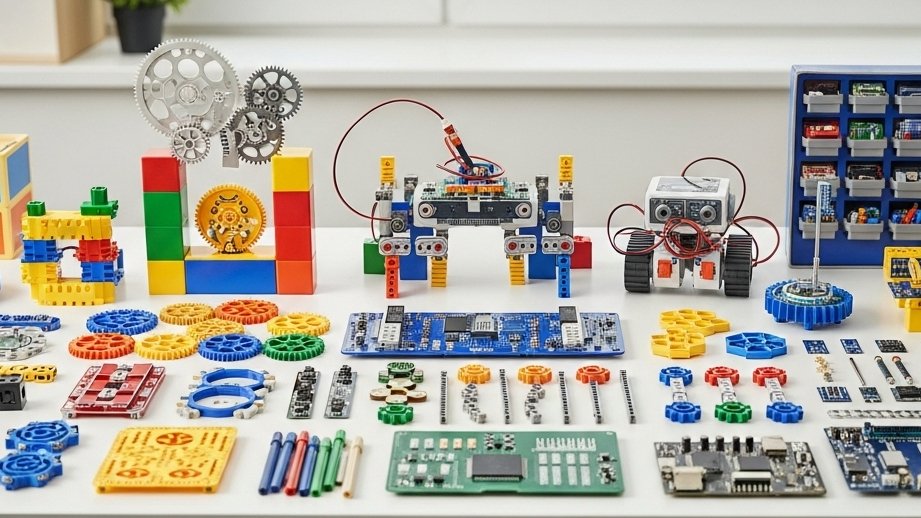In today’s fast-changing world, STEM (Science, Technology, Engineering, and Mathematics) is no longer just a subject taught in classrooms — it’s a way of thinking. Parents, teachers, and even toy companies are investing in STEM & learning kits that spark curiosity and make education fun. These kits combine hands-on projects, problem-solving challenges, and creative experiments to prepare kids for the skills of the future.
But with so many options — from robotics kits to coding sets and chemistry labs — how do you know which one is best? Let’s break it down.
🎯 First Impressions: Learning Meets Fun
What makes STEM kits so appealing is that they turn education into an adventure. Instead of memorizing theories, children get to:
- Build robots 🤖 from scratch.
- Code simple games 💻 on beginner-friendly platforms.
- Mix safe experiments 🧪 that mimic real-world science.
- Design engineering challenges 🔧 that test creativity.
The first impression of a STEM kit is excitement — a toy that’s more than entertainment, offering both fun and functional learning.
📦 Types of STEM Kits Available
STEM learning kits now come in various categories tailored to age groups and interests:
- Robotics Kits 🤖 – Kids assemble robots and program them to move, dance, or respond to commands.
- Coding Kits 💻 – Interactive sets that teach basic programming concepts.
- Science Experiment Kits 🧪 – Chemistry, physics, and biology activities packaged for safe home learning.
- Engineering Kits 🏗️ – Construction sets that teach mechanical principles like gears, pulleys, and levers.
- Math Kits 🔢 – Fun puzzles and number games that improve logical reasoning.
This variety ensures there’s a kit for every child — whether they’re budding scientists, engineers, or tech enthusiasts.
🆚 STEM Kits vs. Traditional Toys
Traditional toys often focus on entertainment and imagination, which are valuable, but STEM kits add another layer: critical thinking and problem-solving.
- Traditional Toys 🎲 → Encourage play and creativity but may lack structured learning outcomes.
- STEM Kits ⚙️ → Blend play with academic concepts, offering practical skills like coding, logical reasoning, and scientific thinking.
This doesn’t mean STEM kits replace regular toys — rather, they enhance learning through purposeful play.
🌍 Why STEM Kits Are Trending in 2025
The popularity of STEM kits is fueled by several cultural and educational shifts:
- 📚 Shift in education → More schools are embracing project-based learning.
- 🌐 Digital-first world → Coding and tech literacy are now core skills.
- 👩🔬 STEM careers on the rise → Parents want to prepare kids early for future opportunities.
- 🎮 Gamification → Children learn better when lessons feel like games.
- 🏠 Homeschooling & remote learning → Parents seek tools to make learning fun at home.
STEM kits fit perfectly into this new ecosystem, where learning must be engaging, accessible, and future-focused.
🛠️ Key Features to Look For in a STEM Kit
When choosing a kit, consider these essential features:
- Age-appropriate design – Younger kids need simple, visual kits, while teens can handle advanced coding or robotics.
- Step-by-step guidance – Clear instructions ensure learning without frustration.
- Hands-on engagement – Activities should involve building, experimenting, or problem-solving.
- Reusability – Kits that can be used multiple times or expanded with upgrades are more valuable.
- Digital integration – Many kits now sync with apps, teaching coding and simulation.
👨👩👧 Who Benefits the Most?
- Kids (Ages 5–15) → The primary audience, developing curiosity and problem-solving.
- Parents → Gain peace of mind knowing their kids’ playtime is educational.
- Teachers → Use STEM kits in classrooms to encourage group projects.
- Homeschooling families → Rely on kits for structured learning outside traditional schools.
These kits are truly multi-generational investments — nurturing young learners while empowering educators.
✅ Pros & Cons of STEM Kits
Pros
- Encourage critical thinking and creativity.
- Bridge the gap between learning and play.
- Prepare kids for future careers.
- Great for both solo and group learning.
Cons
- Can be pricey, especially advanced robotics kits.
- Some require parental supervision for setup.
- Risk of kids losing interest if kits aren’t engaging enough.
🏆 Final Verdict: Are STEM Kits Worth It?
Absolutely. STEM & learning kits are not just toys — they are educational investments that make learning exciting and practical. Compared to traditional toys, they provide long-term value, equipping kids with skills for the digital age.
In 2025, where tech-savvy and problem-solving skills are more important than ever, STEM kits stand out as the perfect blend of fun and future-readiness.
- For parents, they’re peace of mind.
- For kids, they’re a playground of discovery.
- For society, they’re tools shaping tomorrow’s innovators.
✨ Bottom Line: STEM kits aren’t just trending — they’re redefining how children learn, explore, and imagine the future.



